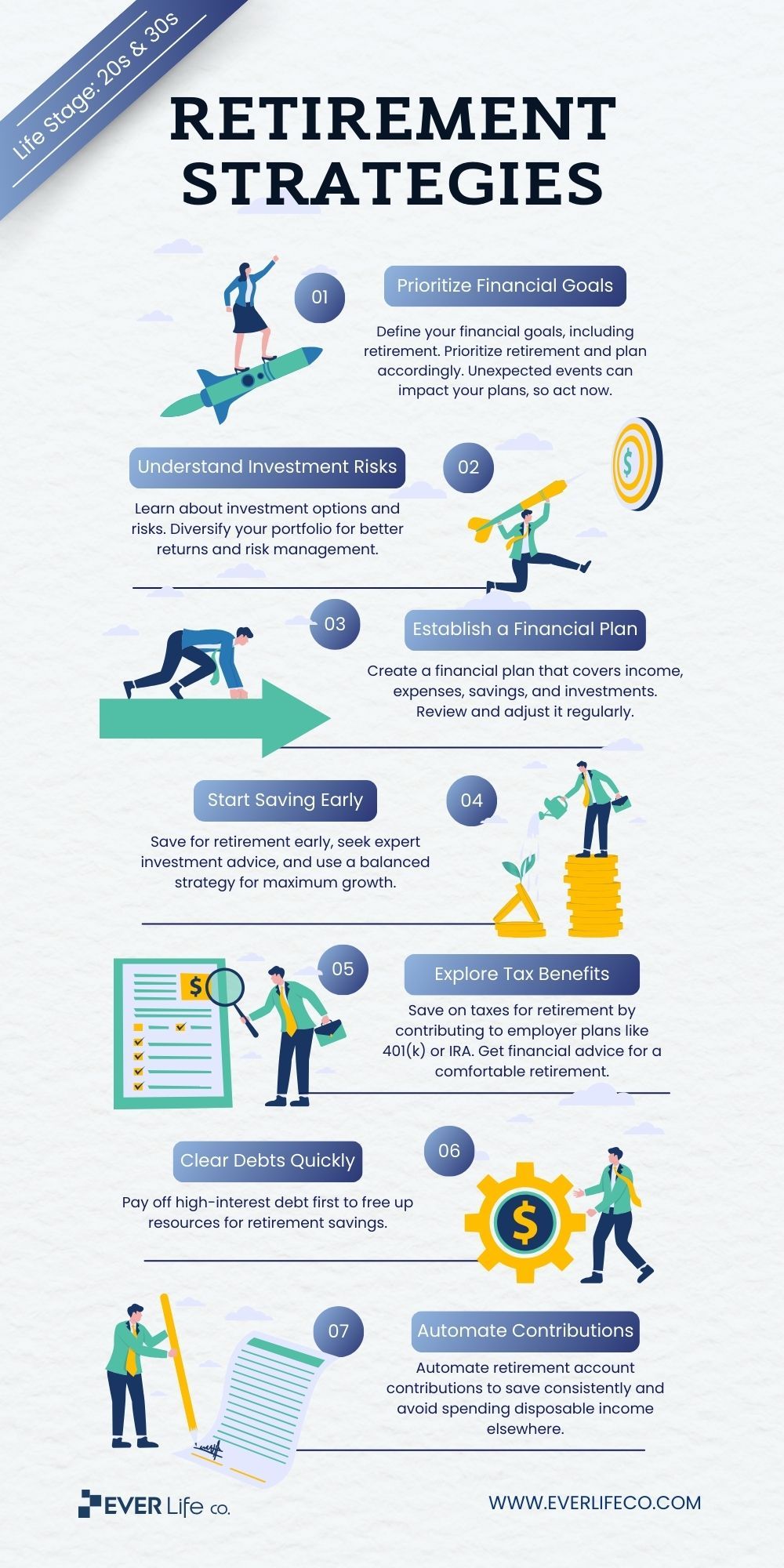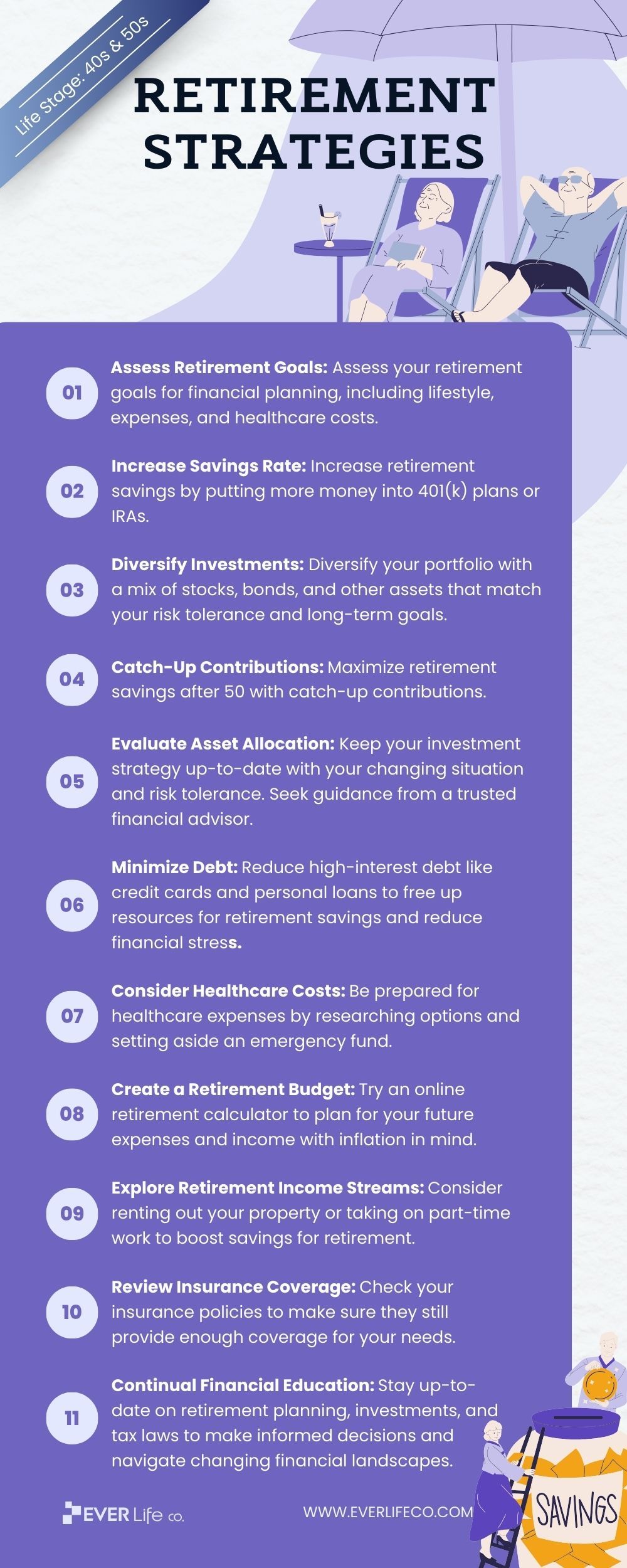Planning for retirement is vital to securing a financially stable and fulfilling future. However, retirement planning is not a one-size-fits-all approach. It requires careful deliberation and adjustments as you navigate through different life stages.
In this blog, we’ll look at:
- The importance of retirement planning and how it translates at different life stages based on your age group and retirement goals;
- Key strategies and considerations tailored for each stage of life.
What is Retirement Planning?
Retirement planning is an undertaking that demands a proactive approach to guarantee a prosperous and gratifying future.
It entails meticulously outlining retirement income objectives and devising a comprehensive strategy to actualize those aspirations. This process encompasses the following:
- Identification of diverse income sources for additional cash flow;
- A thorough assessment of future expenses;
- The implementation of a robust savings regimen;
- Developing responsible spending habits to avoid lifestyle creep;
- Proficient management of assets and potential risks;
- Estimating future cash distribution and flows;
- A comprehensive evaluation of the feasibility of achieving the coveted income goal.
Why is a Retirement Plan Important?
Retirement planning holds immense significance in securing your financial future and ensuring a life of comfort and fulfillment. Let’s delve deeper into the reasons why retirement planning is of paramount importance:
- Financial Security: It enables you to build a solid financial foundation that safeguards your future. It empowers you to accumulate the necessary funds and resources to sustain your lifestyle once you retire.
- Goal Clarity: You can identify and define your future income goals through planning. This process helps you understand the financial milestones you need to achieve for a comfortable retirement.
- Strategic Income Sources: Retirement planning entails evaluating various income sources available during retirement. By exploring options such as pension plans, Social Security benefits, investments, and other potential avenues, you can develop a diversified income portfolio to support your post-retirement needs.
- Expense Evaluation: Effective planning involves assessing your anticipated expenses after you’ve stopped working. By understanding your financial commitments, including healthcare costs, living expenses, and leisure activities, you can accurately estimate the funds required to maintain your desired standard of living.
- Savings Discipline: Implementing a savings program is a crucial step. It instills a disciplined approach to consistently set aside funds designated for retirement, ensuring a substantial nest egg for a bountiful future.
- Asset Management: Retirement planning necessitates managing your assets wisely to maximize their potential growth and protect against risks. You can optimize your assets’ performance and mitigate potential setbacks by understanding investment vehicles, diversification strategies, and risk management techniques.
- Risk Mitigation: Planning for retirement involves evaluating and mitigating potential risks that could adversely affect your financial well-being. Consider contingencies such as health emergencies, market fluctuations, inflation, and longevity risks. You can fortify your financial resilience during retirement by proactively addressing these risks.
- Early Start Advantage: The sooner you commence retirement planning, the greater the benefits. Starting early allows for longer-term financial growth, harnessing the power of compounding and reducing the burden of saving larger sums later in life to compensate for lost time.
- Enjoyment and Freedom: Retirement planning not only ensures financial security but also grants you the freedom and flexibility to pursue your passions and enjoy life to the fullest. It allows you to embark on new adventures, indulge in hobbies, travel, spend quality time with loved ones, and relish the rewards of your lifelong efforts.
Embrace retirement planning as a component of your financial journey and take a proactive stance toward shaping a future that offers stability, prosperity, and the freedom to revel in the experiences that bring you joy.
When is the Ideal Time to Start Planning for Retirement
While it’s never too late to embark on this journey, integrating retirement planning into your financial blueprint at the earliest opportunity yields the most fruitful outcomes.
Integrating retirement planning into your overall financial strategy fortifies the foundations for a secure, worry-free, and enjoyable retirement. It’s precisely the promise of a gratifying and vibrant post-work life that lends significance to the seemingly tedious and serious aspects of planning—envisioning how you will arrive at that idyllic destination.
By dedicating attention to the intricacies of the retirement planning process, you pave the way for a future filled with excitement, fulfillment, and leisure.
Planning for Retirement in Your 20s and 30s
Planning for retirement during your 20s and 30s is a proactive and astute decision that lays the groundwork for a financially secure and fulfilling future.
There might be limits on the availability of surplus funds for investment, especially if you haven’t settled into your career. Still, the true wealth lies in the invaluable asset of time, which plays a pivotal role in building a robust retirement savings plan. This growth potential is because of compounding.
Compound Interest
When you invest or save money, compound interest works in your favor by significantly boosting your savings over time. Here’s a simplified explanation of the snowball effect.
- Initial Investment: Let’s say you invest $1,000. This amount is called the principal.
- Interest Earned: Over time, your investment earns interest. With compound interest, the interest you earn adds to your initial investment of $1000.
- Growing Balance: As time passes, the interest keeps adding up, not just on your initial investment but also on the accumulated interest.
- Accelerating Growth: The longer you keep your money invested, the more significant the impact of compound interest becomes. Your money starts growing faster and faster as the interest compounds.
Compound interest is a remarkable advantage. Even small regular contributions can grow substantially if given enough time to compound. The key is to start early. The longer you invest, the more impressive the growth potential.
To make the most compounding interest and an early start, here are some strategies you can implement when setting up your savings for retirement.
Retirement Strategies for Your 20s and 30s
By implementing the following strategies, you can set yourself up for retirement success:
1 | Prioritizing Financial Goals:
Clearly define your short-term and long-term financial objectives, including retirement. Make retirement a top priority and allocate resources accordingly. You may think you have plenty of time, but the unexpected can throw a wrench in your plans.
2 | Understanding Investment Risks:
Educate yourself about different investment options and the associated risks. Consider diversifying your portfolio to mitigate risk and maximize potential returns.
3 | Establishing a Financial Plan:
Develop a comprehensive financial plan that encompasses your income, expenses, savings goals, and investment strategies. Regularly review and adjust your plan as circumstances evolve.
4 | Starting to Save Early:
Begin saving for retirement as early as possible. Cash savings take time to accumulate, and so does interest if you hope to benefit from compound growth. Seek expert advice on your options. Implement a balanced investment strategy combining investment accounts and product types.
5 | Taking Advantage of Tax Benefits:
Explore retirement-specific tax advantages such as contributing to employer-sponsored retirement plans (e.g., 401(k), 403(b)) or Individual Retirement Accounts (IRAs). Capitalize on tax-deferred growth and potential tax deductions.
Again, seeking financial advice will set you well on your way to retiring the way you want.
6 | Paying off Education Loans and Credit Card Debt Quickly:
Prioritize paying off high-interest debt, such as student loans and credit card balances. Eliminating debt early frees up resources for saving money for retirement.
7 | Setting Up Automatic Contributions to Retirement Accounts:
Opt for automatic contributions to retirement accounts. Automated withdrawals ensure consistent savings without the temptation to spend all of your disposable income elsewhere.
Even the smallest contributions can burgeon into a considerable nest egg. Seize the opportunity to commence your investment journey early, harness the might of compounding, and secure a prosperous future.

Planning for Retirement in Your 40s and 50s
For individuals in their 40s and 50s embarking on retirement planning, adopting strategies that maximize the remaining time available to build a solid financial foundation is essential.
The risks are also higher as you get closer to retirement, as it means less time to recoup lost funds meant for your latter years.
Retirement Strategies for Your 40s and 50s
1 | Assess Retirement Goals:
Evaluate your retirement goals, taking into account desired lifestyle, expenses, and potential healthcare costs. This assessment serves as a roadmap for your financial planning.
2 | Increase Savings Rate:
Boost your savings rate to capitalize on the remaining working years. Consider allocating a higher percentage of your income towards retirement accounts, such as 401(k) plans or IRAs.
3 | Diversify Investments:
Diversify your portfolio to balance risk and potential investment returns. Consider a blend of stocks, bonds, and other assets that match your risk tolerance and long-term objectives.
4 | Catch-Up Contributions:
Take advantage of catch-up contributions allowed by retirement accounts once you reach 50. Catch-up contributions allow for accelerated savings, compensating for any previous shortfalls.
5 | Evaluate Asset Allocation:
Review and fine-tune your asset allocation to ensure it aligns with your changing circumstances and risk tolerance. Work with a reputable financial advisor to optimize your investment strategy.
6 | Minimize Debt:
Prioritize reducing and eliminating high-interest debt, such as credit cards and personal loans. Lowering debt burdens frees up resources for retirement savings and reduces financial stress.
7 | Consider Healthcare Costs:
Plan for potential healthcare expenses, including insurance premiums, long-term care, and Medicare coverage. Research healthcare options and consider setting aside an emergency fund allocated for medical needs.
8 | Create a Retirement Budget:
Develop a comprehensive retirement budget that factors in expected income sources and anticipated expenses. This budgeting exercise helps you gauge the sufficiency of your savings and adjust accordingly.
Use a retirement calculator to help with your estimates. These online apps also account for the inflation rate, which affects the value of your money.
9 | Explore Retirement Income Streams:
Research alternative income streams, such as rental properties, part-time work, or starting a business. Depending on your current skills and occupation, you can start a passive source of additional income.
Increase your annual income with additional sources to supplement retirement savings and provide financial security.
10 | Review Insurance Coverage:
Assess your insurance coverage, including life insurance, disability insurance, and long-term care insurance. Ensure your policies align with your changing needs and provide adequate protection.
11 | Continual Financial Education:
Stay informed about retirement planning trends, investment strategies, and tax laws. Regularly educate yourself to make informed decisions and adapt to evolving financial landscapes.
The main objective for those planning their retirement in their 40s and 50s is to optimize their planning efforts and make the most of the remaining time before retirement with smart and decisive investments.

Retirement Planning Considerations for All Stages
Retirement planning is a lifelong journey that requires careful consideration at all stages. To ensure a financially secure future, you must address critical elements that change throughout your life.
Here are some considerations that span all stages of life.
Life Insurance and Long-Term Care Considerations
Evaluate your life insurance needs to protect your loved ones in case of unexpected events. As you age, adjust your coverage to align with changing financial responsibilities.
Life insurance is cheaper in your 20s and 30s than in your 40s and 50s. Your life expectancy has a direct effect on your rates and premiums. Like retirement planning, the sooner you buy a policy, the better.
Plan for potential long-term care needs, including evaluating long-term care coverage options life insurance riders provide. Balancing the costs and benefits of long-term care coverage is crucial as you approach retirement.
Balancing Risk Tolerance and Investment Diversification
Assess your risk tolerance and adjust your investment portfolio accordingly. While younger individuals can generally afford more risk, a more conservative approach might be advisable as your actual retirement nears.
Diversify investments across various asset classes to mitigate risk. A balanced portfolio can help weather market fluctuations and provide stable returns over the long term.
Evaluating Retirement Account Withdrawal Strategies
Analyze withdrawal strategies for accounts such as 401(k)s and IRAs. Factors to consider include tax implications, required minimum distributions (RMDs), and potential penalties for early withdrawals.
Consult with a financial professional to determine the most tax-efficient and sustainable withdrawal strategy that aligns with your current income and long-term financial goals.
Tax Implications at Different Life Stages
Understand the tax implications of retirement planning at each life stage. This includes considering tax-advantaged accounts, such as Roth IRAs or employer-sponsored plans, and optimizing contributions.
As retirement approaches, evaluate the tax impact of Social Security benefits, pensions, and other sources of income. Minimizing taxable income can maximize your overall retirement funds.
The Shifting Role of Homeownership
Debt consolidation before you’re not actively employed is beneficial. However, the practicality of such a scenario eludes a significant portion of the American population.
If you’re a homeowner, your most substantial asset is likely your home. You’ve spent years building it into a place where your family feels secure. However, the role of a home as an asset changes over time. Unfortunately, this change causes many homeowners to reassess their home’s significance in later years.
Paying for a Mortgage in Your Golden Years
A study by LendingTree revealed that nearly 10 million homeowners aged 65 and older still carry a mortgage. This equates to approximately 19% of homeowners in the 65-and-up age bracket across 50 metropolitan areas who remain encumbered by mortgage debt.
Miami, Los Angeles, and Sacramento, California, stood out as having the highest shares of seniors burdened by ongoing mortgage obligations.
Evaluate your home’s value and purpose in your retirement plan to make informed decisions. Is your home a part of your estate planning strategy? If not, assess whether your current home, once suitable for a growing family, now imposes significant expenses.
An impartial examination will guide you on the optimal course of action, such as downsizing, selling, or exploring alternative options. This objective evaluation ensures your retirement strategy aligns with your growing needs and objectives.
Conclusion
Take a strategic approach to retirement planning. Regardless of which life stage you find yourself in, it’s never too early or too late to start or revisit your retirement planning efforts. Planning for a dream retirement is a lifelong journey that shifts with each life stage; it’s not a one-time event.
It requires continuous evaluation, adjustment, and adaptation as life circumstances change. Seek professional advice for personalized insights tailored to your unique situation and create a solid foundation for a secure and comfortable life after retirement.






